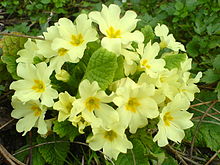| Primula | |
|---|---|

| |
| Primula vulgaris | |
| Scientific classification | |
| Kingdom: | Plantae |
| Clade: | Tracheophytes |
| Clade: | Angiosperms |
| Clade: | Eudicots |
| Clade: | Asterids |
| Order: | Ericales |
| Family: | Primulaceae |
| Subfamily: | Primuloideae |
| Genus: | Primula L. (1753) |
| Type species | |
| Primula veris L. | |
| Species[1] | |
|
528; see text | |
| Synonyms | |
| |
Primula (/ˈprɪmjʊlə/)[2] is a genus of herbaceous[3] flowering plants in the family Primulaceae. They include the primrose (P. vulgaris), a familiar wildflower of banks and verges. Other common species are P. auricula (auricula), P. veris (cowslip), and P. elatior (oxlip). These species and many others are valued for their ornamental flowers. They have been extensively cultivated and hybridised (in the case of the primrose, for many hundreds of years). Primula are native to the temperate Northern Hemisphere, south into tropical mountains in Ethiopia, Indonesia, and New Guinea, and in temperate southern South America. Almost half of the known species are from the Himalayas.[3]
Primula has over 500 species in traditional treatments, and more if certain related genera are included within its circumscription.[4]
- ^ Primula L. Plants of the World Online. Retrieved 8 April 2024.
- ^ Sunset Western Garden Book. 1995. pp. 606–07.
- ^ a b RHS A-Z Encyclopedia of Garden Plants. United Kingdom: Dorling Kindersley. 2008. p. 1136. ISBN 978-1405332965.
- ^ "Primula in Flora of North America @ efloras.org". www.efloras.org. Archived from the original on October 13, 2013. Retrieved 2023-02-19.